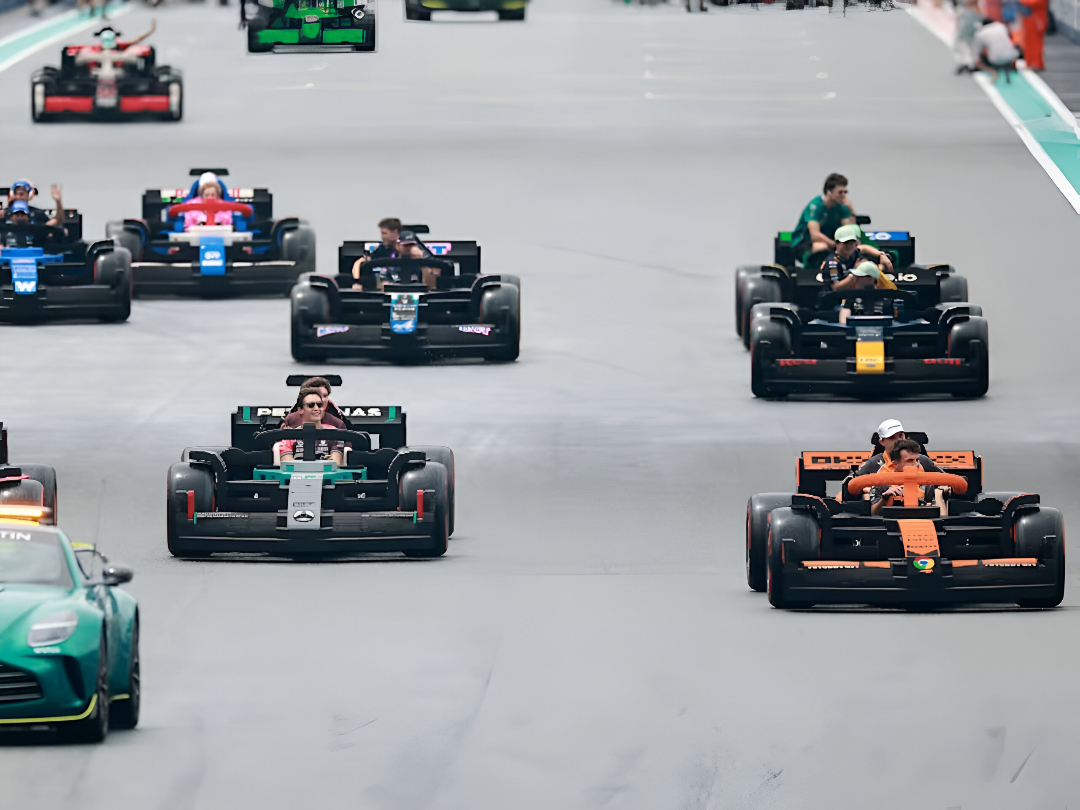The unprecedented collaboration between Formula 1 and LEGO at the 2025 Miami Grand Prix, where traditional drivers’ parade trucks were replaced with fully functional, life-sized LEGO replicas of team cars. These remarkable vehicles combined serious engineering with playful creativity, requiring extensive design innovation to transform rigid plastic bricks into recognizable, drivable F1 cars.
Reimagining the Traditional Drivers’ Parade

The 2025 Miami Grand Prix broke new ground by replacing the conventional truck-based drivers’ parade with custom-built LEGO vehicles. This innovative approach transformed a routine pre-race ceremony into a memorable spectacle that captured global attention. By using life-sized LEGO replicas of actual F1 team cars, organizers created a perfect blend of racing tradition and playful innovation that resonated with fans of all ages while giving drivers a unique experience they enjoyed.
The Massive Scale of Construction

Each team-specific LEGO car required approximately 400,000 individual bricks and weighed around 1,000 kilograms when completed. A specialized team of 26 LEGO professionals devoted over 22,000 hours at the company’s Kladno factory in the Czech Republic to create the full set of vehicles. This extraordinary commitment of resources highlights the technical complexity of the project and the unprecedented scale of these functional LEGO builds, far exceeding typical display models in both size and engineering requirements, making them some of the most impressive LEGO builds ever created.
Functional Engineering Within Constraints

Unlike static LEGO models, these vehicles needed to function as actual drivable cars while maintaining visual fidelity to F1 designs. Engineers built each car around a metal chassis frame with an electric powertrain capable of reaching speeds up to 20km/h. The vehicles needed to accommodate two drivers while withstanding the stresses of actual driving. Most impressively, working steering systems were constructed entirely from LEGO bricks, requiring innovative structural solutions to handle real-world forces without sacrificing the authentic LEGO construction aesthetic.
Bridging Blocky Medium with Aerodynamic Forms

The inherent rectangular nature of LEGO bricks created a fascinating design tension against the sleek, curved aerodynamic profiles of modern Formula 1 cars. Designers embraced this juxtaposition rather than fighting it, leaning into the pixelated aesthetic while ensuring each vehicle remained instantly recognizable as its team’s car. The resulting designs celebrate the distinctive “brick-built” look while still capturing the essential design language of each F1 team through clever layering techniques and strategic brick placement.
Team-Specific Design Language

Each LEGO vehicle faithfully reproduced the distinctive design elements of its corresponding team car. The McLaren featured aggressive front wing sculpting with layered black and orange segments simulating air channels. The Mercedes-AMG Petronas cleverly incorporated turquoise bricks to trace brand elements across side pods and rear wings. The Ferrari’s classic red with yellow accents extended to pixel-rendered shell logos. These details ensure that, despite the unconventional medium, each car maintained its team’s unique visual identity.
Color Strategy and Technical Detailing

Color blocking remained faithful to each team’s livery design while working within LEGO’s available color palette. Williams offset navy blue with white and orange accents, while Red Bull integrated Honda branding through clever brick shading rather than stickers. Designers created physically textured transitions between color sections, demonstrating how three-dimensional LEGO construction could replicate what would typically be achieved through printed graphics on real cars. This approach maintained visual authenticity while embracing the unique materiality of the LEGO medium.
Overcoming Material Limitations

Creating realistic F1 cars with LEGO bricks presented significant design challenges. The complex aerodynamic surfaces with subtle curves don’t naturally align with LEGO’s rectilinear forms. Designers developed creative solutions like stepped approximations of curves and strategic use of specialized pieces to mimic organic shapes while maintaining structural integrity. The limited LEGO color palette required precise combinations to match team-specific brand colors, often achieved through strategic layering of different colored bricks to create the correct visual impression when viewed from race distance.
Engineering for Human Occupancy

Unlike display models, these vehicles needed to safely support human occupants while maintaining proper balance and handling. Designers faced the challenge of weight distribution and structural reinforcement without compromising the authentic LEGO appearance. Strategic placement of support elements and careful chassis integration ensured predictable handling despite the unconventional construction materials. Each car needed to accommodate two drivers from the same team while providing basic controls and safety features within the LEGO aesthetic.
Driver and Fan Reactions

The drivers embraced the unique parade format with enthusiasm and humor. Lewis Hamilton called it “the most fun drivers’ parade we’ve ever had,” while George Russell joked about using the vehicles as “bumper cars” before learning how many hours went into building them. Max Verstappen quipped they would “need to sweep the track” because of “quite a bit of Lego debris” left behind. The parade evolved into a playful competition as drivers raced around the track, demonstrating their competitive nature even in vehicles traveling at relatively slow speeds.
Cultural Impact and Design Innovation

Beyond providing entertainment, these vehicles represent significant design innovation by demonstrating how a restrictive medium can recreate sophisticated forms without sacrificing visual identity. The technical solutions developed for this project could inform approaches to other complex design challenges where standard components must be assembled into functional wholes. Following their Miami debut, all ten LEGO builds will tour globally throughout the 2025 season, allowing design enthusiasts worldwide to appreciate these remarkable creations that successfully merge serious engineering with playful creativity.





























